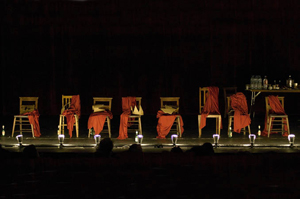Really loving Dave Eggers’ What is the What after strong recommendations from M John Harrison and from Hugo. I’ve always really liked Eggers as a writer of sentences. There’s stuff in Heartbreaking Work and in You Shall Know Our Velocity that has all the energy and verve of Kerouac at his best. I read Kerouac at 17/18 I think, along with Burroughs whose hardcore cut-up Nova Express I accidentally picked up on Derby Market, having mistaken it for something by Edgar (Tarzan) Rice Burroughs, whose probably stupid books about some bloke marooned on Mars I liked. Oh well – I’m glad of these accidents of naming and the alphabet. Some of Kerouac and Burroughs are really embedded in me (though I think thankfully the Rice Burroughs is pretty well all washed away). In Kerouac and Burroughs I found sentences, runs of words, but more than that energies, approaches to language that I still draw on from time to time, in that strange way that we do incorporate language from other people, sample it, replay it, echo it, often unknowing and unwittingly.
Despite the stylistic connection to Kerouac I’ve sometimes been pushed back by the content in Eggers – the whole Real World/MTV thing in the back end of Heartbreaking Work I found too painful, or too thin, I was never sure which. In What is the What though he’s given up on the flowing, stream-of-consciousness, post-Kerouac sentences and on the eternal teenager routine anyway and replaced them with a very tight narrative structure and with what Mike describes as a kind of ventriloquism job; a manoeuvre that has Eggers inhabiting someone else’s life story entirely (that of Sudanese ‘Lost Boy’ Valentino Achak Deng), whilst (at the same time) standing far back from it (writing-wise) in order to let it breathe. No showing off, except the kind of showing off that’s all about not-seeming-to. Really great, awful, disquieting, elegant. Funny too.
Before that I got about one third into We Have to Talk About Kevin. I wasn’t buying really. Didn’t like the narrator, didn’t believe in ‘her/it’ either and I really seemed to be being asked to believe. Had that feeling I get sometimes with overbearing narrators that if I was sat next to this person at a party or on a bus or whatever I would make my excuses and leave. I guess the extended conceit (letters to the ex-partner) started to drive me nuts too.
Listening (meanwhile) to No Age. Can’t remember why a kind of lo-fi Los Angeles punk-duo crossed my radar at this point. Maybe via Other Music. The No Age CD Weirdo Rippers seems very cool I think, just playing some tracks from it here and there at the moment. In fact I am playing the track Everybody’s Down many times over and over and the neighbours are fucking loving it. Ha ha.
Last weeks image residue: canisters of something called patio gas, grinning burning men wrestled to the ground out of flaming Cherokee jeeps by random have-a-go holiday-makers, cops in those white boiler suits again, a forensic facility in Kent called The Igloo, flooded streets, sunken cars and floating skips. Must be Summer.
 Hugo Glendinning has a
Hugo Glendinning has a 